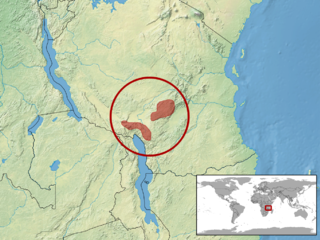
Thomas Barbour was an American herpetologist. He was the first president of the Dexter School in 1926. From 1927 until 1946, he was director of the Harvard Museum of Comparative Zoology (MCZ) founded in 1859 by Louis Agassiz at Harvard University in Cambridge, Massachusetts.

Masticophis flagellum is a species of nonvenomous colubrid snake, commonly referred to as the coachwhip or the whip snake, which is endemic to the United States and Mexico. Six subspecies are recognized, including the nominotypical subspecies.

Masticophis is a genus of colubrid snakes, commonly referred to as whip snakes or coachwhips, which are endemic to the Americas. They are characterized by having a long, thin body and are not dangerous to humans.

Atheris barbouri is a small and rare species of terrestrial viper endemic to the Uzungwe and Ukinga mountains of south-central Tanzania in Africa.

Sistrurus miliarius, commonly called the pygmy rattlesnake, is a species of venomous snake in the subfamily Crotalinae of the family Viperidae. The species is endemic to the Southeastern United States. Three subspecies are currently recognized.

The Cuban ribbontail catshark, is a finback catshark of the family Proscylliidae, found off western central Atlantic Ocean at depths of between 430 and 613 m. It can grow up to a length of 34 cm.
Nototriton barbouri is a species of salamander in the family Plethodontidae. It is endemic to Honduras.

Barbour's map turtle is a species of turtle in the family Emydidae. The species is native to the southeastern United States.
Mixcoatlus barbouri is a venomous pit viper species endemic to Mexico. No subspecies are currently recognized.

The striped whipsnake is a species of nonvenomous snake in the family Colubridae. It is closely related to the California whipsnake. The striped whipsnake is native to the western United States and adjacent northern Mexico.
Barbour's tropical ground snake, also known commonly as Barbour's pygmy snake, is a species of snake in the family Colubridae. The species is endemic to Panama.

Masticophis schotti, commonly known as Schott's whip snake, is a species of snake in the family Colubridae.
Rhabdophis barbouri, also known commonly as Barbour's water snake, is a species of keelback snake in the family Colubridae. The species is endemic to the Philippines.
Masticophis anthonyi, the Clarion Island whip snake, is a species of snake found on Clarion Island in Mexico.
Masticophis aurigulus, the Baja California striped whip snake, is a species of snake found in Mexico.
There are two species of snake named Baja California striped whip snake:
Masticophis bilineatus, the Sonoran whip snake, is a species of snake found in the United States and Mexico.
Masticophis mentovarius, the neotropical whip snake, is a species of snake found in Mexico, Belize, Guatemala, Honduras, El Salvador, Nicaragua, Costa Rica, Panama, Colombia, and Venezuela.
Masticophis slevini, the Isla San Esteban whip snake, is a species of snake found on San Esteban Island in Mexico.








